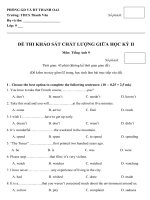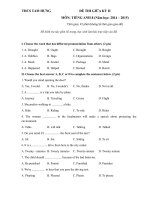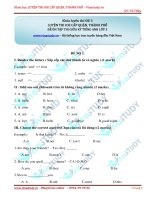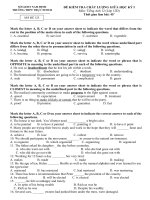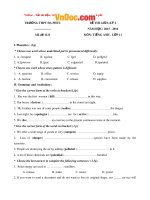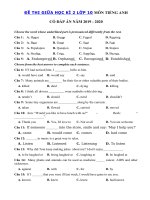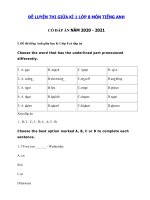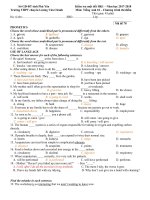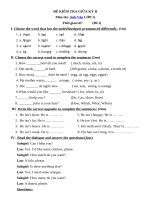BÀI KIỂM TRA GIỮA HỌC KÌ II MÔN: TIẾNG ANH LỚP 11 THẦYCÔ: BAN CHUYÊN MÔN LOIGIAIHAY COM
Bạn đang xem bản rút gọn của tài liệu. Xem và tải ngay bản đầy đủ của tài liệu tại đây (591.94 KB, 20 trang )
<span class="text_page_counter">Trang 1</span><div class="page_container" data-page="1">
<i><b>Mark the letter A, B, C, or D on your answer sheet to indicate the word whose underlined part differs from the other three in pronunciation in each of the following sentences. </b></i>
<b>2. A. ambition </b> B. devotion C. organization <i><b>D. question </b></i>
<i><b>Mark the letter A, B, C, or D on your answer sheet to indicate the word that differs from the other three in the position of primary stress in each of the following sentences. </b></i>
<b>4. A. self-confidence B. punctuality </b> C. intelligence D. experience
<i><b>Mark the letter A, B, C, or D on your answer sheet to indicate the correct answer to each of the following questions. </b></i>
<b>5. Chris bought some gadgets _____ could collect information about health and help him understand himself </b>
better.
<b>6. You’ve downloaded all the new apps to your new phone, _____? </b>
A. have you B. haven’t you C. have they D. haven’t they
<b>7. Most of our classmates use social media to _____ one another. </b>
A. keep touch B. get contacted with C. stay in touch with D. be connected to
<b>8. _____ friends wanted to play computer games with Jimmy, which was a shame. </b>
<b>9. Susan _____ you a message, but I’m not sure. </b>
A. would have sent B. might have sent C. must send D. could send
<b>10. Most of Tommy’s friends have got a Playstation, Xbox, or other _____. </b>
A. bluetooth headset B. camcorder C. game console D. memory stick
<i><b>11. Anna: Let’s chat online. - Bill: _____ </b></i>
A. Not at all. B. Thanks. C. Never mind. D. Good idea.
<b>12. I’ve looked everywhere, but the file appears _____. </b>
A. to misplace B. to be misplaced C. to have misplaced D. to have been misplaced
<b>13. When he was younger, he _____ to the zoo every month. </b>
A. used to go B. was used to going C. was going D. got used to go
<b>14. Dylan’s teacher asked him to tell about a person whom he admired and _____ up to. </b>
<b>15. She never lost her youthful _____ and campaigned for just causes all her life. ĐỀ THI GIỮA HỌC KÌ 2 – ĐỀ SỐ 5 </b>
<b>MƠN: TIẾNG ANH 11 FRIENDS GLOBAL </b>
<b> BIÊN SOẠN: BAN CHUYÊN MÔN LOIGIAIHAY.COM </b>
</div><span class="text_page_counter">Trang 2</span><div class="page_container" data-page="2">A. sociability B. realism C. idealism D. honesty
<i><b>16. Anna: You can’t tell people off for being late if you’re never on time yourself. - Ben: _____. </b></i>
A. Go ahead B. Enlighten me. C. No doubt about it. D. You can count on me
<i><b>Give the correct form of each word in brackets. </b></i>
<b>17. Although Mike is a child, he’s aware of what he should do and _______ enough for his studying. </b>
(RESPONSIBILITY)
<b>18. Many ________ relax in the evenings in spite of having large amounts of homework. (TEENAGE) 19. She's stubborn and selfish, but ________ clever. (DENY) </b>
<b>20. With the _________ of major new markets, the economy is thriving. (ESTABLISH) </b>
<i><b>Read the following passage and mark the letter A, B, C, or D on your answer sheet to indicate the correct word or phrase that best fits each of the numbered blanks. </b></i>
<b>Recently launched AI (21)_____ like ChatGPT have captured the public's imagination. They offer (22)_____ users the chance to interact with what is known as "generative AI", (23)_____ can summarise information </b>
from multiple sources within seconds, debug computer code and write presentations.
<b>Their rollout has sparked renewed debate (24)_____ the role of AI in society, by offering a tangible illustration </b>
of the potential risks and rewards of the new technology. Calls for the dramatic rise in emerging AI to be better
<b>regulated have been coming thick and (25)_____, from both politicians and tech leaders. </b>
<i><b>Read the following passage and mark the letter A, B, C, or D on your answer sheet to indicate the correct answer to each of the questions. </b></i>
Mickey Mouse, an animated cartoon character created by Walt Disney and Ub Iwerks, is considered the most popular and recognizable cartoon character in the world. Mickey made his first public appearance in Steamboat Willie on November 18, 1928, which established his core characteristics: cheerful in spirit, yet roughish in complexion. Mickey was often joined by his girlfriend, Minnie Mouse, as well as an animated
<b>gang of friends that included Donald Duck, Goofy, and Pluto. The earliest cartoons portrayed Mickey as a </b>
country boy living in the Midwest.
Mickey is easily identified by his round ears, red shorts, white gloves, and yellow shoes. Actually, throughout his existence, Mickey has undergone a few changes. In 1940, Mickey was given pupils in his eyes. Later, he would lose his trademark red pants and start wearing different clothes.
Originally, Walt Disney did Mickey Mouse's vocal expressions such as whistling, laughing, or crying. Mickey did not actually speak until 1929 and interestingly enough, Mickey's first words were "Hot dogs! Hot dogs!"
</div><span class="text_page_counter">Trang 3</span><div class="page_container" data-page="3">One of the reasons why Walt Disney was much more successful than other animators at that time was because of his use of sound. He created a soundtrack to match the scenes in the cartoons.
Mickey Mouse has appeared in over 130 films. “When people laugh at Mickey Mouse, it's because he's so human; and that is the secret of his popularity, said Walt Disney.
In 1978, Mickey became the first cartoon character to receive a star on the Hollywood Walk of Fame. Today, Mickey stands as the highest-grossing animated character of all time. As its most famous character, Mickey
<b>Mouse serves as the mascot of the Walt Disney Company and is well-known all over the world. 26. What is the main idea of the passage? </b>
A. Walt Disney - animation pioneer B. Success story of Walt Disney C. Mickey Mouse's first public appearance D. Mickey Mouse's life and history
<i><b>27. The word “portrayed” in the passage is closest in meaning to __________. </b></i>
<b>28. It can be inferred from the passage that __________. </b>
A. most animation companies were creating silent animations when Walt Disney’s cartoons were soundtracked
B. most animators except for Walt Disney made a series of drawings on paper C. unlike other animators, Walt Disney didn’t create Mickey Mouse alone D. the soundtrack is a musical film Walt Disney created
<b>29. According to the passage, all of the following statements are true EXCEPT ___________. </b>
A. Mickey first public appeared in 1928
B. Mickey was the first cartoon character to speak, and his first words were… “hot dogs”. C. Thanks to Mickey Mouse, Walt Disney became an animator
D. Mickey Mouse got his star on the Hollywood Walk of Fame in 1978
<i><b>30. The word “mascot” in the passage is closest in meaning to ___________. </b></i>
<i><b>Mark the letter A, B, C, or D on your answer sheet to indicate the sentence that is CLOSEST in meaning to each of the following questions. </b></i>
<b>31. Katie couldn’t get the job because she wasn’t confident. </b>
A. It was because of Katie’s lack of confidence that she couldn’t get the job. B. If Katie was confident, she could get the job.
C. Katie wished she were more confident because she couldn’t get the job. D. Not getting the job, Katie wasn’t confident.
<b>32. It is compulsory to wear seat belts in cars. </b>
A. We need to wear seat belts when driving cars. B. We must wear seat belts when travelling by car. C. We are supposed to wear seat belts in cars.
</div><span class="text_page_counter">Trang 4</span><div class="page_container" data-page="4">D. We don’t have to wear seat belts in cars.
<b>33. Mark works harder than anyone else in this office. </b>
A. It’s Mark who works hardest.
B. It’s Mark who works harder than anyone else in this office. C. It’s in this office that no one works except Mark.
D. Hardly does anyone else in this office work like Mark does.
<i><b>Mark the letter A, B, C, or D on your answer sheet to indicate the sentence that best combines each pair of sentences in the following questions. </b></i>
<b>34. The game was very difficult. They decided to quit it. </b>
A. The game was so difficult and they quit it immediately. B. It was so difficult that they decided to quit.
C. Such was difficult a game that they quit.
D. It was such a difficult game that they decided to quit it.
<b>35. The reporter will question the man. His house was broken into last night. </b>
A. The man whose house was broken into last night will be questioned by the reporter. B. The reporter will question the man whose house was broken into.
C. The man will inform the reporter about his house which was broken into. D. The reporter will announce that the man’s house was broken into last night.
<i><b>People are having problems using these gadgets or machines. What is the problem with each one? Listen and circle the correct answer. </b></i>
</div><span class="text_page_counter">Trang 6</span><div class="page_container" data-page="6"><b>Chris bought some gadgets that could collect information about health and help him understand himself better. </b>
<i>(Chris đã mua một số thiết bị có thể thu thập thơng tin về sức khỏe và giúp anh ấy hiểu bản thân mình hơn.) </i>
Chọn B
<b>6. B </b>
<b>Kiến thức: Câu hỏi đi Giải thích: </b>
Câu hỏi đi ở thì hiện tại hoàn thành mượn trợ động từ “have”.
<b>You’ve downloaded all the new apps to your new phone, haven’t you? </b>
<i>(Bạn đã tải tất cả ứng dụng mới xuống điện thoại mới của mình phải khơng?) </i>
Chọn B
<b>7. C </b>
<b>Kiến thức: Cụm động từ Giải thích: </b>
<i>Cụm từ: stay in touch with = keep in touch with (giữ liên lạc với ai đó) </i>
<b>Most of our classmates use social media to stay in touch with one another. </b>
<i>(Hầu hết các bạn cùng lớp của chúng tôi sử dụng mạng xã hội để giữ liên lạc với nhau.) </i>
Chọn C
</div><span class="text_page_counter">Trang 7</span><div class="page_container" data-page="7"><b>8. B </b>
<b>Kiến thức: Lượng từ Giải thích: </b>
A. A few + danh từ đếm được số nhiều: ít
B. Few + danh từ đếm được số nhiều: ít (không đủ, nghĩa tiêu cực) C. Some + danh từ: Một số
D. None + of + danh từ: Khơng có
<b>Few friends wanted to play computer games with Jimmy, which was a shame. </b>
<i>(Rất ít bạn bè muốn chơi trị chơi trên máy tính với Jimmy, điều đó thật đáng tiếc.) </i>
Chọn B
<b>9. B </b>
<b>Kiến thức: Động từ khuyết thiếu Giải thích: </b>
A. would have sent: lẽ ra đã gửi B. might have sent: có thể đã gửi C. must send: phải gửi
D. could send: có thể gửi
<b>Susan might have sent you a message, but I’m not sure. </b>
Chọn B
<b>10. C </b>
<b>Kiến thức: Từ vựng Giải thích: </b>
A. bluetooth headset (n): tai nghe bluetooth B. camcorder (n): máy quay phim
C. game console (n): máy chơi game D. memory stick (n): thẻ nhớ
<b>Most of Tommy’s friends have got a Playstation, Xbox, or other game console. </b>
<i>(Hầu hết bạn bè của Tommy đều có Playstation, Xbox hoặc máy chơi game khác.) </i>
C. Never mind: Đừng bận tâm D. Good idea: Ý tưởng hay đấy
</div><span class="text_page_counter">Trang 8</span><div class="page_container" data-page="8"><i><b>Anna: Let’s chat online. - Bill: Good idea. </b></i>
<i>(Anna: Hãy trò chuyện trực tuyến. - Bill: Ý tưởng hay đấy.) </i>
Chọn D
<b>12. D </b>
<b>Kiến thức: Câu bị động Giải thích: </b>
Cấu trúc bị động hồn thành cho hành động đã xảy ra trước đó trong quá khứ: to have been Ved/V3
<b>I’ve looked everywhere, but the file appears to have been misplaced. </b>
<i>(Tơi đã tìm khắp nơi nhưng hình như file đó bị thất lạc.) </i>
Chọn D
<b>13. A </b>
<b>Kiến thức: Cấu trúc “used to” Giải thích: </b>
used to V: đã từng làm gì trong quá khứ
get used to + V-ing: dần quen với một việc gì đó ở hiện tại
<b>When he was younger, he used to go to the zoo every month. </b>
<i>(Khi còn nhỏ, anh ấy thường đến sở thú hàng tháng.) </i>
Chọn A
<b>14. A </b>
<b>Kiến thức: Cụm động từ Giải thích: </b>
A. look up to: tôn trọng
B. stand up to: giữ nguyên tắc riêng mình khi bị tra khảo bởi cơ quan thẩm quyền C. come up to: đến một nơi cụ thể
D. make up to: đền bù, bù đắp cho ai đó vì một lỗi lầm
<b>Dylan’s teacher asked him to tell about a person whom he admired and looked up to. </b>
<i>(Giáo viên của Dylan yêu cầu cậu kể về một người mà cậu ngưỡng mộ và kính trọng.) </i>
B. realism (n): chủ nghĩa hiện thực C. idealism (n): chủ nghĩa duy tâm D. honesty (n): trung thực
<b>She never lost her youthful idealism and campaigned for just causes all her life. </b>
</div><span class="text_page_counter">Trang 9</span><div class="page_container" data-page="9"><i>(Cô ấy không bao giờ đánh mất lý tưởng tuổi trẻ của mình và vận động vì chính nghĩa trong suốt cuộc đời </i>
B. Hãy khai sáng cho tơi. C. Khơng cịn nghi ngờ gì nữa. D. Bạn có thể tin tưởng vào tôi
<i><b>Anna: You can’t tell people off for being late if you’re never on time yourself. - Ben: You can count on me. </b></i>
<i>(Anna: Bạn không thể chê trách mọi người vì đến muộn nếu bản thân bạn khơng bao giờ đến đúng giờ. - Ben: Bạn có thể tin tưởng vào tôi.) </i> responsible (adj): chịu trách nhiệm
<b>Although Mike is a child, he’s aware of what he should do and responsible enough for his studying. </b>
<i>(Mặc dù Mike còn là một đứa trẻ nhưng cậu ấy đã nhận thức được mình nên làm gì và có trách nhiệm với việc </i>
Sau “many” cần một danh từ số nhiều. teenage (adj): thiếu niên
teenager (n): thiếu niên
<b>Many teenagers relax in the evenings in spite of having large amounts of homework. </b>
<i>(Nhiều thanh thiếu niên thư giãn vào buổi tối mặc dù có rất nhiều bài tập về nhà.) </i>
Đáp án: teenagers
<b>19. undeniably </b>
<b>Kiến thức: Từ vựng – Từ loại Giải thích: </b>
</div><span class="text_page_counter">Trang 10</span><div class="page_container" data-page="10">Trước tính từ “clever” cần trạng từ. deny (v): từ chối
undeniably (adj): không thể phủ nhận
<b>She's stubborn and selfish, but undeniably clever. </b>
<i>(Cô ấy bướng bỉnh và ích kỷ, nhưng khơng thể phủ nhận thông minh.) </i>
<b>With the establishment of major new markets, the economy is thriving. </b>
<i>(Với việc thành lập các thị trường mới lớn, nền kinh tế đang phát triển mạnh.) </i>
<b>Recently launched AI (21) tool like ChatGPT have captured the public's imagination. </b>
<i>(Công cụ AI (21) mới ra mắt gần đây như ChatGPT đã chiếm được trí tưởng tượng của công chúng.) </i>
Chọn B
<b>22. B </b>
<b>Kiến thức: Từ vựng Giải thích: </b>
A. ordinary (adj): bình thường B. usual (adj): thông thường
C. common (adj): phổ biến, trung tính
D. popular (adj): phổ biến, được nhiều người ưa thích, mang nghĩa tích cực
<b>They offer (22) usual users the chance to interact with what is known as "generative AI", … </b>
<i>(Họ cung cấp (22) người dùng thông thường cơ hội tương tác với cái được gọi là "AI sáng tạo", ...) </i>
Chọn B
<b>23. C </b>
</div><span class="text_page_counter">Trang 11</span><div class="page_container" data-page="11"><b>Kiến thức: Mệnh đề quan hệ Giải thích: </b>
Dùng đại từ quan hệ “which” thay thế cho AI trong mệnh đề quan hệ Không xác định. that: không được sử dụng trong mệnh đề quan hệ Không xác định
this (đại từ): đây/ này
bebate over + N: tranh luận về cái gì
<b>Their rollout has sparked renewed debate (24) over the role of AI in society, by offering a tangible illustration </b>
of the potential risks and rewards of the new technology.
<i>(Việc triển khai của họ đã làm dấy lên cuộc tranh luận mới (24) về vai trò của AI trong xã hội, bằng cách đưa ra một minh họa hữu hình về những rủi ro và lợi ích tiềm ẩn của công nghệ mới.) </i>
thick and fast (idiom): nhanh chóng và với số lượng lớn.
<b>Calls for the dramatic rise in emerging AI to be better regulated have been coming thick and (25) fast, from </b>
both politicians and tech leaders.
<i>(Những lời kêu gọi sự gia tăng mạnh mẽ của AI mới nổi cần được quản lý tốt hơn ngày càng dày đặc và (25) nhanh chóng, từ cả các chính trị gia và các nhà lãnh đạo cơng nghệ.) </i>
Chọn A
<b>Đoạn văn hồn chỉnh: </b>
<b>Recently launched AI (21) tool like ChatGPT have captured the public's imagination.They offer (22) usual users the chance to interact with what is known as "generative AI", (23) which can summarise information </b>
from multiple sources within seconds, debug computer code and write presentations.
</div><span class="text_page_counter">Trang 12</span><div class="page_container" data-page="12"><b>Their rollout has sparked renewed debate (24)over the role of AI in society, by offering a tangible illustration </b>
of the potential risks and rewards of the new technology.Calls for the dramatic rise in emerging AI to be better
<b>regulated have been coming thick and (25) fast, from both politicians and tech leaders. Tạm dịch: </b>
<i>Công cụ AI (21) mới ra mắt gần đây như ChatGPT đã chiếm được trí tưởng tượng của cơng chúng. Họ cung cấp cho (22) người dùng thông thường cơ hội tương tác với cái được gọi là "AI sáng tạo", (23) có thể tóm tắt thơng tin từ nhiều nguồn trong vài giây, gỡ lỗi mã máy tính và viết bài thuyết trình. </i>
<i>Việc triển khai của họ đã làm dấy lên cuộc tranh luận mới (24) về vai trò của AI trong xã hội, bằng cách đưa ra một minh họa hữu hình về những rủi ro tiềm ẩn và phần thưởng của công nghệ mới. Những lời kêu gọi sự gia tăng mạnh mẽ của AI mới nổi để được quản lý tốt hơn đã ngày càng dày đặc và (25) nhanh chóng, từ cả chính trị gia và các nhà lãnh đạo công nghệ. </i>
<b>Bài đọc: </b>
Mickey Mouse, an animated cartoon character created by Walt Disney and Ub Iwerks, is considered the most popular and recognizable cartoon character in the world. Mickey made his first public appearance in Steamboat Willie on November 18, 1928, which established his core characteristics: cheerful in spirit, yet roughish in complexion. Mickey was often joined by his girlfriend, Minnie Mouse, as well as an animated
<b>gang of friends that included Donald Duck, Goofy, and Pluto. The earliest cartoons portrayed Mickey as a </b>
country boy living in the Midwest.
Mickey is easily identified by his round ears, red shorts, white gloves, and yellow shoes. Actually, throughout his existence, Mickey has undergone a few changes. In 1940, Mickey was given pupils in his eyes. Later, he would lose his trademark red pants and start wearing different clothes.
Originally, Walt Disney did Mickey Mouse's vocal expressions such as whistling, laughing, or crying. Mickey did not actually speak until 1929 and interestingly enough, Mickey's first words were "Hot dogs! Hot dogs!" One of the reasons why Walt Disney was much more successful than other animators at that time was because of his use of sound. He created a soundtrack to match the scenes in the cartoons.
Mickey Mouse has appeared in over 130 films. “When people laugh at Mickey Mouse, it's because he's so human; and that is the secret of his popularity, said Walt Disney.
In 1978, Mickey became the first cartoon character to receive a star on the Hollywood Walk of Fame. Today, Mickey stands as the highest-grossing animated character of all time. As its most famous character, Mickey
<b>Mouse serves as the mascot of the Walt Disney Company and is well-known all over the world. Tạm dịch: </b>
<i>Chuột Mickey, một nhân vật hoạt hình hoạt hình do Walt Disney và Ub Iwerks tạo ra, được coi là nhân vật hoạt hình nổi tiếng và dễ nhận biết nhất trên thế giới. Mickey xuất hiện trước công chúng lần đầu tiên trong Steamboat Willie vào ngày 18 tháng 11 năm 1928, điều này đã tạo nên những đặc điểm cốt lõi của anh: tinh thần vui vẻ nhưng nước da thô ráp. Mickey thường có bạn gái của anh ấy, Chuột Minnie, cũng như một nhóm </i>
</div>